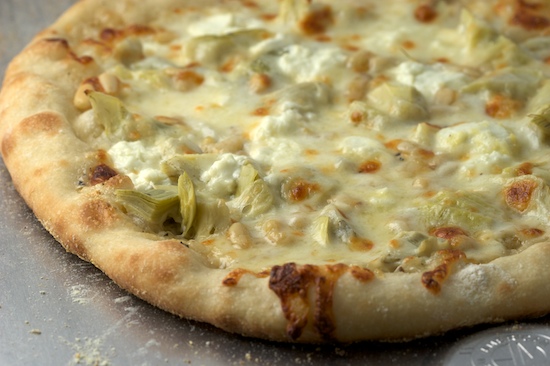Original recipe taken from “The Bread Baker’s
Apprentice” by Peter Reinhart.
Makes
6 pizza crusts (about 9-12 inches/23-30 cm in diameter).
Ingredients:
4 1/2 Cups (20 1/4 ounces/607.5 g) Unbleached high-gluten (%14) bread flour or all purpose flour, chilled –
1 3/4 Tsp Salt
1 Tsp Instant yeast
1/4 Cup (2 ounces/60g) Olive oil or vegetable oil
1 3/4 Cups (14 ounces/420g or 420ml) Water, ice cold (40° F/4.5° C)
1 Tb sugar
4 1/2 Cups (20 1/4 ounces/607.5 g) Unbleached high-gluten (%14) bread flour or all purpose flour, chilled –
1 3/4 Tsp Salt
1 Tsp Instant yeast
1/4 Cup (2 ounces/60g) Olive oil or vegetable oil
1 3/4 Cups (14 ounces/420g or 420ml) Water, ice cold (40° F/4.5° C)
1 Tb sugar
Semolina/durum
flour or cornmeal for dusting
~
Day One ~
Method:
1. Mix together the flour, salt and instant yeast in a big bowl (or in the bowl of your stand mixer).
1. Mix together the flour, salt and instant yeast in a big bowl (or in the bowl of your stand mixer).
2.
Add the oil, sugar and cold water and mix well (with the help of a large wooden
spoon or with the paddle attachment, on low speed) in order to form a sticky
ball of dough. On a clean surface, knead for about 5-7 minutes, until the dough
is smooth and the ingredients are homogeneously distributed. If it is too wet,
add a little flour (not too much, though) and if it is too dry add 1 or 2
teaspoons extra water.
NOTE: If you are using an electric mixer,
switch to the dough hook and mix on medium speed for the same amount of time.The
dough should clear the sides of the bowl but stick to the bottom of the bowl. If
the dough is too wet, sprinkle in a little more flour, so that it clears the
sides. If, on the contrary, it clears the bottom of the bowl, dribble in a
teaspoon or two of cold water. The finished dough should be springy, elastic,
and sticky, not just tacky, and register 50°-55° F/10°-13° C.
3.
Flour a work surface or counter. Line a jelly pan with baking paper/parchment.
Lightly oil the paper.
4.
With the help of a metal or plastic dough scraper, cut the dough into 6 equal
pieces (or larger if you want to make larger pizzas).
NOTE: To avoid the dough from sticking to the
scraper, dip the scraper into water between cuts.
5.
Sprinkle some flour over the dough. Make sure your hands are dry and then flour
them. Gently round each piece into a ball.
NOTE: If the dough sticks to your hands, then
dip your hands into the flour again.
6.
Transfer the dough balls to the lined jelly pan and mist them generously with
spray oil. Slip the pan into plastic bag or enclose in plastic food wrap.
7.
Put the pan into the refrigerator and let the dough rest overnight or for up to
thee days.
NOTE: You can store the dough balls in a
zippered freezer bag if you want to save some of the dough for any future
baking. In that case, pour some oil (a few tablespooons only) in a medium bowl
and dip each dough ball into the oil, so that it is completely covered in oil.
Then put each ball into a separate bag. Store the bags in the freezer for no
longer than 3 months. The day before you plan to make pizza, remember to
transfer the dough balls from the freezer to the refrigerator.
~
Day Two ~
8.
On the day you plan to eat pizza, exactly 2 hours before you make it, remove the
desired number of dough balls from the refrigerator. Dust the counter with flour
and spray lightly with oil. Place the dough balls on a floured surface and
sprinkle them with flour. Dust your hands with flour and delicately press the
dough into disks about 1/2 inch/1.3 cm thick and 5 inches/12.7 cm in diameter.
Sprinkle with flour and mist with oil. Loosely cover the dough rounds with
plastic wrap and then allow to rest for 2 hours.
9.
At least 45 minutes before making the pizza, place a baking stone on the lower
third of the oven. Preheat the oven as hot as possible (500° F/260° C).
NOTE: If you do not have a baking stone, then
use the back of a jelly pan. Do not preheat the pan.
10.
Generously sprinkle the back of a jelly pan with semolina/durum flour or
cornmeal. Flour your hands (palms, backs and knuckles). Take 1 piece of dough by
lifting it with a pastry scraper. Lay the dough across your fists in a very
delicate way and carefully stretch it by bouncing it in a circular motion on
your hands, and by giving it a little stretch with each bounce. Once the dough
has expanded outward, move to a full toss.
NOTE: Make only one pizza at a time. During
the tossing process, if the dough tends to stick to your hands, lay it down on
the floured counter and reflour your hands, then continue the tossing and
shaping.
In case you would be having trouble tossing the dough or if the dough never wants to expand and always springs back, let it rest for approximately 5-20 minutes in order for the gluten to relax fully, then try again.
You can also resort to using a rolling pin, although it isn’t as effective as the toss method.
In case you would be having trouble tossing the dough or if the dough never wants to expand and always springs back, let it rest for approximately 5-20 minutes in order for the gluten to relax fully, then try again.
You can also resort to using a rolling pin, although it isn’t as effective as the toss method.
11.
When the dough has the shape you want (about 9-12 inches/23-30 cm in diameter –
for a 6 ounces/180g piece of dough), place it on the back of the jelly pan,
making sure there is enough semolina/durum flour or cornmeal to allow it to
slide and not stick to the pan.
12.
Lightly top it with sweet or savory toppings of your choice.
NOTE: Remember that the best pizzas are topped
not too generously. No more than 3 or 4 toppings (including sauce and cheese)
are sufficient.
13.
Slide the garnished pizza onto the stone in the oven or bake directly on the
jelly pan. Close the door and bake for abour 5-8 minutes.
NOTE: After 2 minutes baking, take a peek. For
an even baking, rotate 180°.
If
the top gets done before the bottom, you will need to move the stone or jelly
pane to a lower shelf before the next round. On the contrary, if the bottom
crisps before the cheese caramelizes, then you will need to raise the stone or
jelly.
14.
Take the pizza out of the oven and transfer it to a cutting board or your plate.
In order to allow the cheese to set a little, wait 3-5 minutes before slicing or
serving.
So
far, I’ve made three of the six pizzas, and they’ve all been really great! Like
I mentioned earlier, I’ve had problems with the dough becoming too thin when I
toss it, but the flavor of the crust has really been superb!
I
normally bake on parchment paper directly on the baking stone. I use parchment
paper rather than dusting the peel with cornmeal because it just seems less
messy! But since the recipe specified using cornmeal or semolina to dust the
the pizza peel, I did use that method for my first pizza:
This
dough was hand tossed but it had to be tossed several times because it kept
flying off to the side and landing in a crumpled mess. I eventually got
something that resembled the shape of a pizza and quickly transferred it to the
cornmeal-dusted pizza peel. I topped it with a garlic cream sauce, grated
mozzarella, goat cheese, artichoke hearts, and toasted pine nuts. These were
ingredients that I just happened to have on hand.
I
slid the pizza onto the stone in my oven that had been preheated to 550
degrees. I’m pretty sure my oven never reached 550 degrees, but it was pretty
hot. Here you can see the pizza on the stone, viewed through the dirty glass on
my oven door!
It
took only about six minutes to bake, and the result was gorgeous (and
delicious)!





















